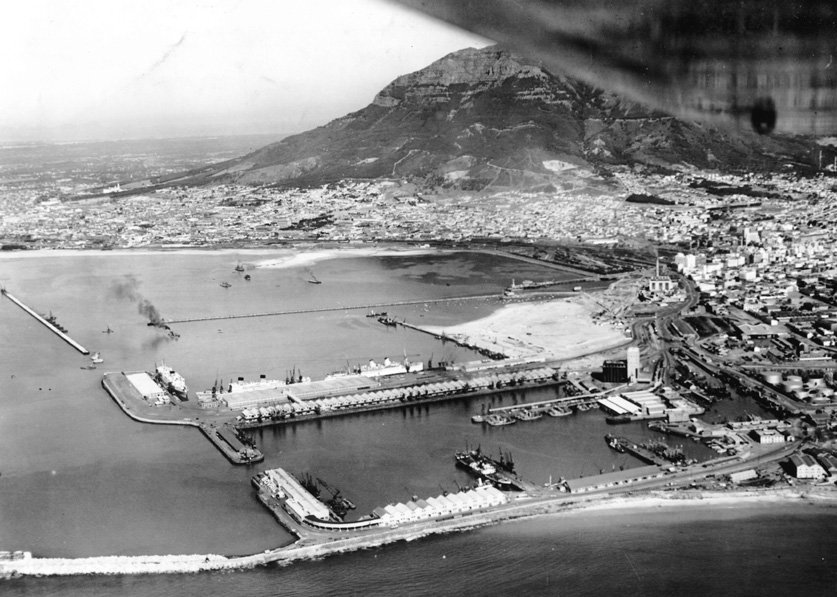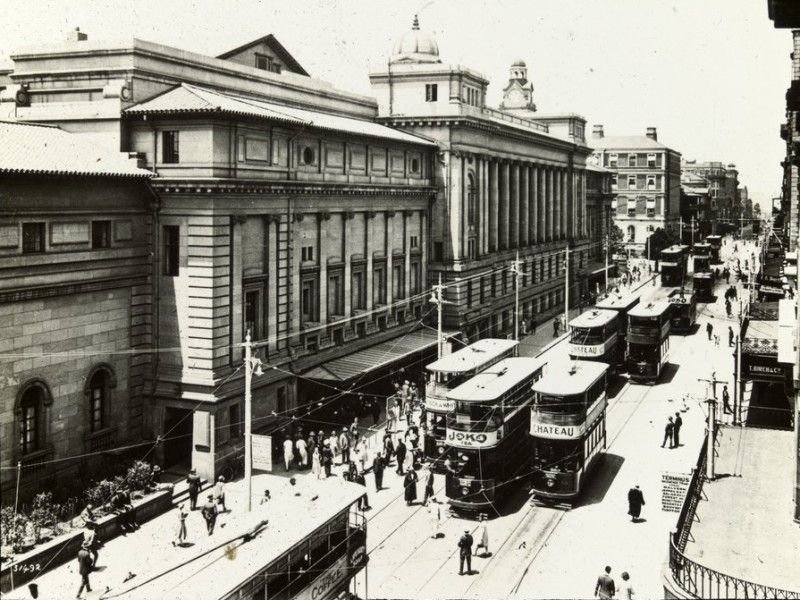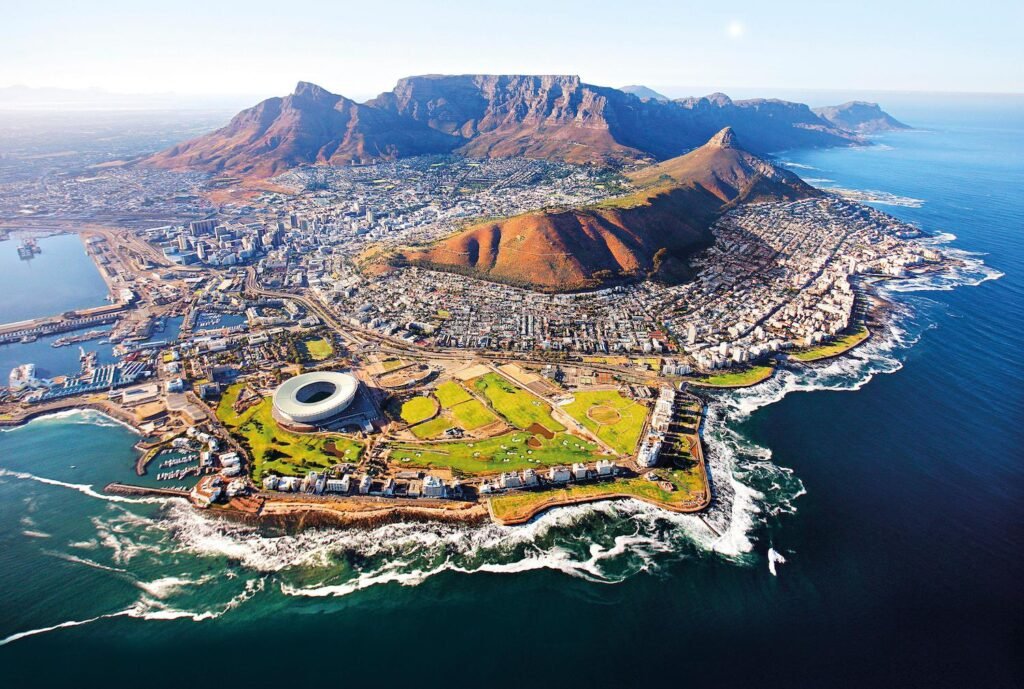Cape Town Then and Now
Cape Town Then
Cape Town, located in South Africa, is a city rich in history and cultural significance.
The region has been inhabited for thousands of years, with archaeological evidence from Peers Cave in Fish Hoek indicating human activity dating back between 12,000 and 15,000 years.
Indigenous Khoikhoi groups, such as the Gorinaiqua, thrived in this area for millennia, living off the land and raising cattle, which later played a crucial role in shaping the region’s colonial economy.
The arrival of European explorers marked a turning point in its history; Bartolomeu Dias was the first to reach the area in 1488, naming it the “Cape of Storms” due to its treacherous waters.
However, King John II of Portugal renamed it the “Cape of Good Hope” to reflect the optimism brought by discovering a maritime route to India and the East Indies.
This pivotal moment heralded Cape Town’s future as a significant port city and a vital link in global trade routes.

Cape Town History
Cape Town’s development as a city and port is deeply intertwined with its strategic location and rich history of cultural, economic, and political evolution.
The first European to anchor at Table Bay and climb Table Mountain was Portuguese navigator António de Saldanha, who encountered the indigenous Khoekhoe people.
These communities thrived on herding, hunting, and gathering, and their presence shaped the early dynamics between European visitors and the region’s resources.
Related Article: Johannesburg Then and Now
Following Saldanha’s visit, the Dutch East India Company established a supply station in 1652 under Jan van Riebeeck, laying the foundations for Cape Town’s colonial settlement.
The introduction of free burghers, slaves, and political exiles from the Dutch East Indies led to a mixed and growing population, forming the basis of the town’s early societal structure.
Cape Town’s growth accelerated during the 18th century due to its strategic importance.
Related Article: Cairo Then and Now
Rising international tensions, such as those during the Seven Years’ War and the American Revolution, brought increased attention to the Cape as a key maritime stop.
The British, recognizing its value, occupied the Cape in 1795, marking the beginning of a series of administrative changes.
By 1840, Cape Town officially became a municipality, incorporating nearby suburbs and establishing governance structures funded by property taxes.
Related Article: Denver Then and Now

The city’s population expanded with the discovery of diamonds and gold inland, as well as improved infrastructure, such as roads, railways, and the Alfred Dock.
The 20th century brought profound changes, particularly in the context of urbanization, industrialization, and racial politics.
Cape Town’s early municipal governance allowed for diverse representation, but apartheid-era legislation in 1972 disenfranchised nonwhite citizens, sparking protests and resistance.
The city’s opposition to apartheid policies, including a major peaceful march in 1989, played a role in the broader national movement that led to the release of Nelson Mandela and the eventual dismantling of apartheid.
Related Article: Seattle Then and Now
With the transition to majority rule in the 1990s, Cape Town’s government underwent significant restructuring.
The Municipal Structures Act of 1998 expanded the city’s boundaries and integrated municipal services to better serve all residents.
Today, Cape Town reflects a dynamic blend of its historical roots, cultural diversity, and modern advancements, making it a significant urban center in South Africa.
Related Article: Dallas Then and Now
Cape Town Now

Cape Town, known as South Africa’s “Mother City,” is the country’s oldest urban area and the legislative capital.
Renowned for its historical and natural significance, it houses the South African Parliament and serves as the cultural and economic hub of the Western Cape.
Founded by the Dutch East India Company (VOC) in 1652 as a supply station for ships traveling to the East, the city became the first permanent European settlement in South Africa under Jan van Riebeeck.
Related Article: Miami Then and Now
Over time, Cape Town expanded beyond its initial role, developing into a major economic and cultural center of the Cape Colony, and remained the largest city in southern Africa until the Witwatersrand Gold Rush spurred Johannesburg’s growth.
Cape Town’s scenic beauty and biodiversity are unparalleled, with its iconic Table Mountain, Cape Point, and expansive coastline along the Atlantic Ocean, including False Bay.
It lies at the northern end of the Cape Peninsula and is surrounded by stunning natural landscapes, including the Table Mountain National Park and other protected areas that preserve its rich flora and fauna.
Related Article: Washington D.C. Then and Now
The cityscape is a blend of steep mountain slopes, sprawling suburbs, and coastal areas, covering an area of 116 square miles (300 square kilometers).
Cape Town is also a global tourist destination, celebrated for its vibrant culture, history, and breathtaking scenery.
Related Article: Boston Then and Now
It has been repeatedly recognized as one of the world’s best places to visit, earning accolades from The New York Times and The Daily Telegraph.
Its mix of urban sophistication and proximity to nature, combined with a rich cultural heritage, makes Cape Town a unique and dynamic metropolis in South Africa.
Related Article: San Francisco Then and Now
FAQs
Cape Town is famous for its stunning natural beauty, iconic landmarks like Table Mountain and Cape Point, rich cultural heritage, and vibrant history as South Africa’s oldest city.
Cape Town can be expensive for tourists, especially in popular areas, but costs vary. Accommodation, dining, and activities range from budget-friendly to luxury options.
Cape Town’s main languages are English, Afrikaans, and Xhosa, reflecting its diverse population.
The currency used in Cape Town is the South African Rand (ZAR).






























